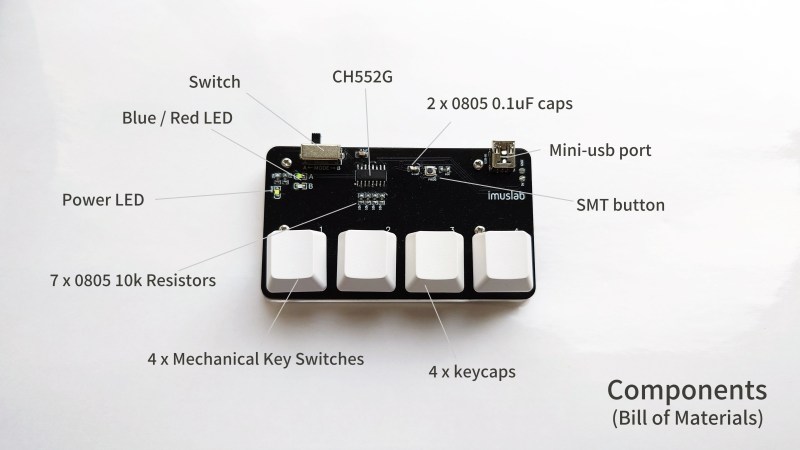Supercon 2022 showed that hackers are starting to come together again in Maker Faires, conventions, and festivals. [Toby Chui] plans to be one of those hackers and wants something to give to fellow attendees. Thus, the $3 Macro Pad was born.
We’ve seen our fair share of macro pads, so a simple four-key pad isn’t exactly novel. However, the focus on size and cost makes it stand out. The pad is the size of a business card, making it easy to give away. For a microcontroller, [Toby] used a CH552G, which is cheap and compatible with the Arduino IDE. Although, with 10 GPIO, a matrix layout could have supported a full-sized number pad, the diodes required would have added to the cost significantly. A cheap PCB and 3d-printed base make up the device’s bulk.
[Toby] provides a handy tool for assigning keys from your browser without coding. However, the source code is on GitHub if you want to develop a more complicated scheme. This isn’t the first time we’ve featured the CH552 chip, and it likely won’t be the last.















Nice!
(Though at first thought, upon seeing CH552 in the Title Photo, I thought it was a relative of the 555 B^)
That would be the 558, and I re all another quad timer with similar number
I can’t find the keycaps and the switchs themselves in the BOM, and I think they represent the vast majority of the cost in any macropad.
Exactly my thought. I dont know you, but from here, buying 4 * (keycap+switch) alone is worth more than 3$, not even including shipping. Wherever i buy those : local store, local internet, aliexpress, ..
on amazon, switches go from 50cts to 1€ depending on quantity… each. Maybe they have better prices in Hong Kong ?
The price is the real reason not everyone has a mechanical keyboard, for the elitists out there.
I don’t know for sure, but i guess at least in Shenzen inside the big electronic part buildings the prices are really, really low; but maybe not if you are a tourist/stranger?
Anyway, yes this 3$/3€ is misleading; although the finished product looks nice.
Here caps (small plastic-only part) are more expensive than the switch itself, which has always made me wonder..
Outemu makes some good keyswitches for not much. You can get a set of 110 for under $20, so under $0.20 per. Keycaps, if you’re not picky, can be even cheaper.
That leaves maybe $1.50 for the rest. It’s tight, but that’s why you use a $0.25 microcontroller.
I have been considering building one here to help with some ill-projected business applications, but have not decided on an easy way ( that doesn´t involve a 3d printer ) to build a “body” that would look like a mouse, for the left hand, with the pad buttons spaced on the fingers position. This “4 in a row” buttons end up a little tiresome to use after some time…
I get the three buttons: ctrl, alt & delete.
but what are the last button for?
Backspace..
Cntrl-Alt-Delete could be on just one key, so there’s 3 extra.
For Linux compatibility?
Maybe to add back the Turbo button that computer manufacturers have been leaving off lately
My burning question is: “Why use MINI USB in 2022?” Seriously! That was the worst USB format ever!
Why use it? Because (s)he had some in stock maybe?
Also why was it the worst? If it works no problem, no need to put USB-C everywhere (which is more complex to route and solder and …)!
So who packs a min USB cable (or adapter) when going anywhere, in the last X (10?) years? Mini USB was the worst mechanical USB design of all and failed all too often, especially for surface mount, which is why it was replaced with the micro. If you’re challenged by USB-C, use a micro USB.
I’ve never liked micro-USB and I think mini-USB was much better.
To each his own. I have more micro USB than any other type (5x?) and for a longer time frame (at least twice as many years), so it makes sense that I might experience more usage related failures with micro USB, but I can’t say that, at least in my experience. Mini USB has been the only type that I’ve had that completely pulled away from the surface mount solder joints.
Micro-USB failed far more than mini-USB because of the “springy teeth” and of the wrong-way connections. Plug cycles are higher on micro-USB but that was for ideal use.
I have never seen a failed mini connector but I have seen many failed micro connectors (however few smartphones have had a mini connector).
Mini-USB is a better design and has only been superseded for size reasons.
I had much more issues with microusb than miniusb; micro would bend and break long before it ran out of lifetime in terms of insertions, which is where I’m told micro should be better. Or even more commonly than that, it would start only working when the connector was inserted just right and would disconnect whenever the device or cable was bumped.
“Although, with 10 GPIO, a matrix layout could have supported a full-sized number pad, the diodes required would have added to the cost significantly. ”
But surely you aren’t pushing multiple numpad keys simultaneously, so there will never be an issue with ghosting, and therefore don’t need diodes at all?
One more vote for USB-C. At least dual pads and have the choice. I even got some C to USB 2.0 on little PCB for pennies.
Micro and Mini are awful. Both of them.
“the diodes required would have added to the cost significantly”
Really? Maybe if you order them in the west and insist on a gold-plated priority shipping box – with insurance and tracking.
Or was that some kind of joke?
Anyway; the commenters are right, the cost are the keys and keycaps.